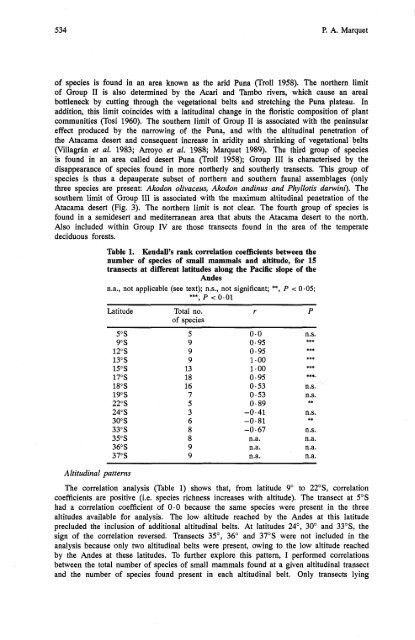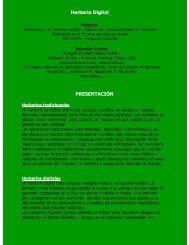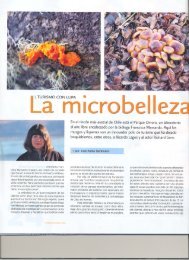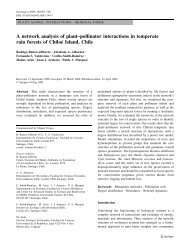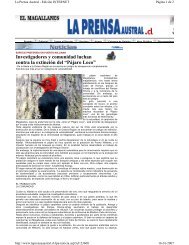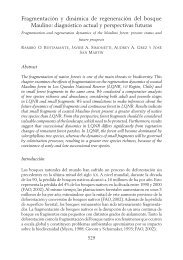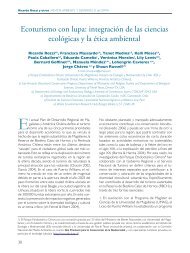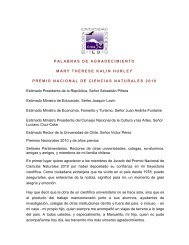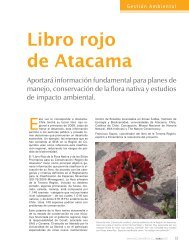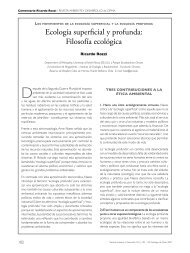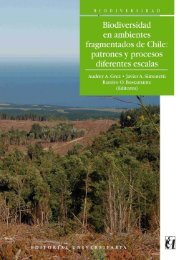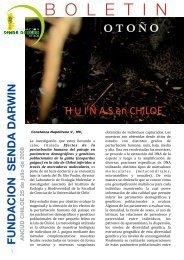534 P. A. Marquet<strong>of</strong> species is found <strong>in</strong> an area known as <strong>the</strong> arid Puna (Troll 1958). The nor<strong>the</strong>rn limit<strong>of</strong> Group I1 is also determ<strong>in</strong>ed by <strong>the</strong> Acari and Tambo rivers, which cause an arealbottleneck by cutt<strong>in</strong>g through <strong>the</strong> vegetational belts and stretch<strong>in</strong>g <strong>the</strong> Puna plateau. Inaddition, this limit co<strong>in</strong>cides with a latitud<strong>in</strong>al change <strong>in</strong> <strong>the</strong> floristic composition <strong>of</strong> plantcommunities (Tosi 1960). The sou<strong>the</strong>rn limit <strong>of</strong> Group I1 is associated with <strong>the</strong> pen<strong>in</strong>sulareffect produced by <strong>the</strong> narrow<strong>in</strong>g <strong>of</strong> <strong>the</strong> Puna, and with <strong>the</strong> altitud<strong>in</strong>al penetration <strong>of</strong><strong>the</strong> Atacama desert and consequent <strong>in</strong>crease <strong>in</strong> aridity and shr<strong>in</strong>k<strong>in</strong>g <strong>of</strong> vegetational belts(Villagrf<strong>in</strong> et al. 1983; Arroyo et al. 1988; Marquet 1989). The third group <strong>of</strong> speciesis found <strong>in</strong> an area called desert Puna (Troll 1958); Group I11 is characterised by <strong>the</strong>disappearance <strong>of</strong> species found <strong>in</strong> more nor<strong>the</strong>rly and sou<strong>the</strong>rly transects. This group <strong>of</strong>species is thus a depauperate subset <strong>of</strong> nor<strong>the</strong>rn and sou<strong>the</strong>rn faunal assemblages (onlythree species are present: Akodon olivaceus, Akodon and<strong>in</strong>us and Phyllotis darw<strong>in</strong>i). Thesou<strong>the</strong>rn limit <strong>of</strong> Group 111 is associated with <strong>the</strong> maximum altitud<strong>in</strong>al penetration <strong>of</strong> <strong>the</strong>Atacama desert (Fig. 3). The nor<strong>the</strong>rn limit is not clear. The fourth group <strong>of</strong> species isfound <strong>in</strong> a semidesert and mediterranean area that abuts <strong>the</strong> Atacama desert to <strong>the</strong> north.Also <strong>in</strong>cluded with<strong>in</strong> Group IV are those transects found <strong>in</strong> <strong>the</strong> area <strong>of</strong> <strong>the</strong> temperatedeciduous forests.Altitud<strong>in</strong>al patternsTable 1. Kendall's rank correlation coefficients between <strong>the</strong>number <strong>of</strong> species <strong>of</strong> small mammals and altitude, for 15transects at different latitudes along <strong>the</strong> <strong>Pacific</strong> slope <strong>of</strong> <strong>the</strong>Andesn.a., not applicable (see text); n.s., not significant; **, P < 0.05;***, P < 0.01Latitude Total no. r P<strong>of</strong> species5"s 5 0.0 n.s.9" S 9 0.95 ***12"s 9 0.95 ***13"s 9 1.00 ***15"s 13 1.00 ***17"s 18 0.95**t18"s 16 0.53 n.s.19"s 7 0.5322"s 5 0.89n.s.**n.s.30"s 6 -0.81 **24"s 3 -0.4133"s 8 -0.67 n.s.35"s 8 n.a. n.a.36"s 937"s 9n.a.n.a.n.a.n.a.The correlation analysis (Table 1) shows that, from latitude 9" to 22"S, correlationcoefficients are positive (i.e. species richness <strong>in</strong>creases with altitude). The transect at 5OShad a correlation coefficient <strong>of</strong> 0.0 because <strong>the</strong> same species were present <strong>in</strong> <strong>the</strong> threealtitudes available for analysis. The low altitude reached by <strong>the</strong> Andes at this latitudeprecluded <strong>the</strong> <strong>in</strong>clusion <strong>of</strong> additional altitud<strong>in</strong>al belts. At latitudes 24", 30" and 33"S, <strong>the</strong>sign <strong>of</strong> <strong>the</strong> correlation reversed. Transects 35", 36" and 37"s were not <strong>in</strong>cluded <strong>in</strong> <strong>the</strong>analysis because only two altitud<strong>in</strong>al belts were present, ow<strong>in</strong>g to <strong>the</strong> low altitude reachedby <strong>the</strong> Andes at <strong>the</strong>se latitudes. To fur<strong>the</strong>r explore this pattern, I performed correlationsbetween <strong>the</strong> total number <strong>of</strong> species <strong>of</strong> small mammals found at a given altitud<strong>in</strong>al transectand <strong>the</strong> number <strong>of</strong> species found present <strong>in</strong> each altitud<strong>in</strong>al belt. Only transects ly<strong>in</strong>g
<strong>Diversity</strong> <strong>of</strong> <strong>Small</strong> <strong>Mammals</strong> <strong>in</strong> a <strong>Coastal</strong> <strong>Desert</strong>with<strong>in</strong> <strong>the</strong> desert area were <strong>in</strong>cluded (i.e. 5-24"s). The results (Table 2) show that <strong>the</strong>number <strong>of</strong> species found <strong>in</strong> <strong>the</strong> altitud<strong>in</strong>al belts above 3000 m is positively correlatedwith <strong>the</strong> total number <strong>of</strong> species with access to a particular altitud<strong>in</strong>al transect. That is,an <strong>in</strong>crease <strong>in</strong> <strong>the</strong> number- <strong>of</strong> species <strong>in</strong> latitude only affect high-altitude environments;species tend to accumulate <strong>in</strong> <strong>the</strong> highlands. The factors affect<strong>in</strong>g species diversity behavedifferently below 3000 m. Regional diversity probably affects local diversity (see Ricklefs1987) only <strong>in</strong> those areas located above 3000 m, whereas below it <strong>the</strong> existence <strong>of</strong> <strong>the</strong>coastal desert imposes a serious barrier to <strong>the</strong> passive diffusion or spill-over <strong>of</strong> species fromareas <strong>of</strong> high diversity <strong>in</strong> <strong>the</strong> highlands. In this scenario it is not surpris<strong>in</strong>g that desertlowland species may have evolved physiological adaptations, such as hydric <strong>in</strong>dependenceand torpor (see K<strong>of</strong>ord 1968; Boz<strong>in</strong>ovic and Marquet 1991), to cope with one <strong>of</strong> <strong>the</strong>world's most arid deserts (Borgel 1973).Table 2. Kendall's rank correlation coefficients between <strong>the</strong>total number <strong>of</strong> species present at each altitud<strong>in</strong>al transectand <strong>the</strong> number <strong>of</strong> species found at each altitud<strong>in</strong>al beltn, number <strong>of</strong> observations; n.s., not significant; ***, P c 0.01Altitud<strong>in</strong>al belt (m) n r PIn general, <strong>the</strong>se results are consistent with previous studies (Pearson 1951, 1982;Spotorno 1976; Pearson and Ralph 1978; Pizzimenti and DeSalle 1981) that po<strong>in</strong>t out<strong>the</strong> existence <strong>of</strong> a positive correlation between species richness and altitude <strong>in</strong> <strong>the</strong> areabetween <strong>the</strong> <strong>Pacific</strong> coastal desert and <strong>the</strong> Puna. At this po<strong>in</strong>t it is <strong>in</strong>terest<strong>in</strong>g to notethat this f<strong>in</strong>d<strong>in</strong>g contradicts <strong>the</strong> rule <strong>of</strong> decreas<strong>in</strong>g number <strong>of</strong> species with <strong>in</strong>crease <strong>in</strong>altitude (e.g. Stevens 1992 and references <strong>the</strong>re<strong>in</strong>). A negative correlation between speciesrichness and altitude is likely to arise if most speciation events have occurred <strong>in</strong> lowlandhabitats. Therefore, species' primary adaptations are suited to lowland environments, andhighlands represent, to some extent, stressful habitats that are difficult to colonise and<strong>in</strong> which to persist. However, <strong>in</strong> <strong>the</strong> case <strong>of</strong> <strong>the</strong> <strong>Coastal</strong> desert-Puna axis, <strong>the</strong> oppositeoccurs. Here, most speciation events were associated with high-altitude environments, wherea major centre <strong>of</strong> species diversification was located. The primary adaptations <strong>of</strong> <strong>the</strong>sespecies were to cope with cold, high-altitude environments, and lowland habitats were <strong>of</strong>marg<strong>in</strong>al value. Hence <strong>the</strong> positive correlation between altitude and species richness. Asan alternative hypo<strong>the</strong>sis, it could be argued that <strong>the</strong> positive correlation emerges because<strong>of</strong> <strong>the</strong> existence <strong>of</strong> a lowland hyperarid desert that limits diversity <strong>in</strong> lowland areas tosuch low levels as to produce a pattern <strong>of</strong> positive correlation that would o<strong>the</strong>rwise benegative. Although I do not deny that <strong>the</strong> onset <strong>of</strong> arid conditions <strong>in</strong> <strong>the</strong> lowlands caused<strong>the</strong> ext<strong>in</strong>ction <strong>of</strong> some species (Marquet 1989), <strong>the</strong> historical effect <strong>of</strong> a high-altitude centre<strong>of</strong> diversification seems more pervasive. The key evidence <strong>in</strong> support <strong>of</strong> this hypo<strong>the</strong>sisis <strong>the</strong> existence <strong>of</strong> a positive correlation between species richness and altitude along <strong>the</strong>eastern side <strong>of</strong> <strong>the</strong> Andes Cordillera (Patton 1986; Cadle and Patton 1988; J. Salazar,T. Yates and P. Marquet, unpublished data), where Puna vegetation gives way to Yungasforest and lowland tropical ra<strong>in</strong>forest.As emphasised earlier, <strong>the</strong> existence <strong>of</strong> a high-altitude centre <strong>of</strong> biotic diversification hasaffected both latitud<strong>in</strong>al and altitud<strong>in</strong>al patterns <strong>of</strong> species diversity, leav<strong>in</strong>g strong signsbeh<strong>in</strong>d, such as a latitud<strong>in</strong>al peak <strong>in</strong> species richness (Fig. 4) and an 'anomalous' positivecorrelation between species richness and altitude. The onset <strong>of</strong> hyperarid conditions dur<strong>in</strong>g


